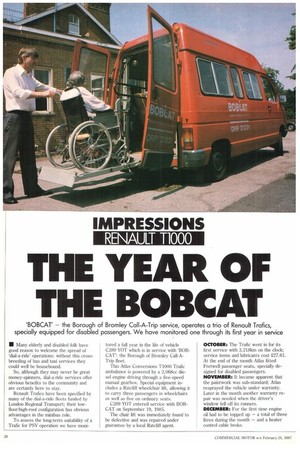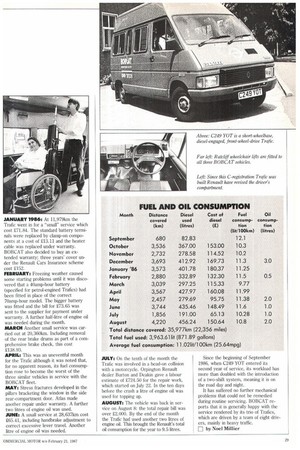THE YEAR OF
Page 30

Page 31

If you've noticed an error in this article please click here to report it so we can fix it.
THE BOBCAT
'BOBCAT' — the Borough of Bromley Call-A-Trip service, operates a trio of Renault Trafics, specially equipped for disabled passengers. We have monitored one through its first year in service • Many elderly and disabled folk have good reason to welcome the spread of 'dial-a-ride' operations: without this crossbreeding of bus and taxi services they could well be housebound.
So, although they may never be great money-spinners, dial-a-ride services offer obvious benefits to the community and are certainly here to stay.
Renault Trafics have been specified by many of the dial-a-ride fleets funded by London Regional Transport; their lowfloor/high-roof configuration has obvious advantages in the minibus role.
To assess the long-term suitability of a Trafic for PSV operation we have moni tored a full year in the life of vehicle C289 YOT which is in service with 'BOBCAT: the Borough of Bromley Call-ATrip fleet.
This Atlas Conversions T1000 Trafic ambulance is powered by a 2,068cc diesel engine driving through a five-speed manual gearbox. Special equipment includes a Ratcliff wheelchair lift, allowing it to carry three passengers in wheelchairs as well as five on ordinary seats.
C289 YOT entered service with BOBCAT on September 19, 1985.
The chair lift was immediately found to be defective and was repaired under guarantee by a local Ratcliff agent. OCTOBER: The Trafic went in for its first service with 3,218km on the clock; service items and lubricants cost 227.61. At the end of the month Atlas fitted Fretwell passenger seats, specially designed for disabled passengers. NOVEMBER: It became apparent that the paintwork was sub-standard; Atlas resprayed the vehicle under warranty. Later in the month another warranty repair was needed when the driver's window fell off its runners, DICIAIBER: For the first time engine oil had to be topped up — a total of three litres during the month — and a heater control cable broke.
JANUARY 1986: At 11,979km the Trafic went in tor a "small" service which cost £71.84. The standard battery terminals were replaced by clamp-on components at a cost of 213.11 and the heater cable was replaced under warranty. BOBCAT also decided to buy an extended warranty; three years' cover under the Renault Cars Insurance scheme cost £152.
FEBRUARY: Freezing weather caused some starting problems until it was discovered that a 40amp-hour battery (specified for petrol-engined Trafics) had been fitted in place of the correct 70amp-hour model. The bigger battery was fitted and the bill for £73.65 was sent to the supplier for payment under warranty. A further half-litre of engine oil was needed during the month.
MARCH Another small service was carried out at 20,360km, Including removal of the rear brake drums as part of a comprehensive brake check, this cost £138.93.
APRIL: This was an uneventful month for the Trafic although it was noted that, for no apparent reason, its fuel consumption rose to become the worst of the three similar vehicles in service with the BOBCAT fleet.
MAY: Stress fractures developed in the pillars bracketing the window in the side rear-compartment door. Atlas made another repair under warranty. A further two litres of engine oil was used.
JUNE: A small service at 28,637km cost £65.41, including handbrake adjustment to correct excessive lever travel. Another litre of engine oil was needed. JULY: On the tenth of the month the Tralic was involved in a head-on collision with a motorcycle. Orpington Renault dealer Burton and Deakin gave a labour estimate of £724.50 for the repair work, which started on July 22. In the ten days before the crash a litre of engine oil was used for topping up.
AUGUST: The vehicle was back in service on August 8: the total repair bill was over 22,000. By the end of the month the Trafic had used another two litres of engine oil. This brought the Renault's total oil consumption for the year to 95 litres. Since the beginning of September 1986, when C249 YOT entered its second year of service, its workload has more than doubled with the introduction of a two-shift system, meaning it is on the road day and night.
It has suffered no further mechanical problems that could not be remedied during routine servicing. BOBCAT reports that it is generally happy with the service rendered by its trio of Trafics, which are driven by a team of eight drivers, mainly in heavy traffic.
by Noel Millier












































































